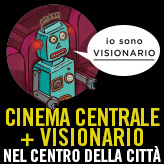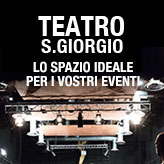In the middle of Hell
Fabrizio Pallara
CREDITSarchitectural design Sara Ferazzoli
application development and implementation of VR Alessandro Passoni

Immersive Virtual Reality technology
The experience is intended for audience members over the age of 14
Dante writes in his letter to Cangrande della Scala that the aim of the Divine Comedy, and as such the purpose of his artistic endeavours, was to help humanity achieve happiness ("to remove those living in this life from their state of misery and lead them to the state of felicity").
If we start from this point of view, the journey into the afterlife can be interpreted as a journey into the self and an exploration of the deepest frailties, fears, feelings of inadequacy and limitation that are to be found in the many facets of humanity. The journey becomes a search for trust, examined through a dimension of being that transcends earthly limits and connects the human with the divine.
Dante wrote the Inferno while he was suffering from the pain and alienation of being exiled, forced to live away from his home and burdened by the weight of injustice. This difficult situation clearly had an effect on his life and his writing, allowing him to rise up and achieve a new balance within himself and with the world, reaching a new dimension of knowledge.
In this way, the poet created the possibility of inventing another world, one that both reflects and is connected to the real world, where the self can find a direct experience of evolution and transformation. This is the beginning of modern literature, and, inspired by these ideas, this experience-based theatrical project uses immersive Virtual Reality technology to put the audience in contact with the possibility of another world. This is a fantastical dimension that is not separate or dissociated from reality, but rather interconnected with it, in the belief that the fantastical and the virtual are much more deeply embedded in reality than is commonly held.
As such, the journey will not only bring us into contact with the other world (which is both the world of the dead and the virtual world of immersive reality), above all it will be an introspective experience exploring the world of the self.
The journey will be divided into two parts:
The first part (the same for all the audience) will consist of a prologue and the initial part of the journey.
The second part (chosen by the individual audience member) will consist of the exploration of a space chosen from the nine Circles of Hell, and an encounter with one of the characters.
We will begin with a prologue: a space to welcome our guests and an initial meditation focussed on a mirror that will invite everyone to look upon their own self - as Dante did with the character of himself. The audience are asked why they are making this journey, what are their wishes and expectations, and what obstacles and fears they must be overcome.
A guide will accompany each audience member, asking each one this initial question and inviting them to make a courageous choice. These words fill the heart with desire and invite us to be daring. As the guide accompanies the audience in this first part, they will also explain how the immersive journey will take place: how to put on the headset, what to do to enter this world and how to travel through it. One by one, the audience members will then be accompanied beyond the wall that separates the here-and-now from the hereafter and set off on their journey, initially along a corridor that leads to a room. As they walk along the real space of the corridor, the forest will appear virtually: an insidious darkness they must overcome and avoid being drawn in. Here they will encounter with the wild beasts that threaten to block their path, and meet Virgil, their guide and teacher.
At this point, the Gates of Hell open wide, leading to the place “where all light was mute”. It is here that the second part begins, in the real room they have now reached. Here, King Minos judges the sins of the audience members just as he judges the damned in Dante's tale.
Each one must tell the infernal monster which sin they feel is most closely and personally connected to them.
According to the sin they describe, Minos will then send each audience member to the corresponding circle of Hell.
As they descend via an elevator, they will glimpse the conditions of the other circles before reaching their own. Here they will be welcomed to this immersive world, becoming the director of their own experience.
There will be nine options to choose from, one for each of the circles of hell. Each one corresponds to a specific sin, punishment and character to meet.
At the end of the twenty-minute experience, the voice of Virgil, who will have accompanied them through the entire journey, will lead the viewer out of the experience.
The dimension of Hell will be created based on Dante's text and on research into the iconographic tradition, but it will be represented through pure and essential forms and dimensions. The architectural space becomes an expression of the emotions, a conduit for feelings. It will draw on the poetic and abstract language of contemporary architecture that evokes a sensation of alienation and excitement. All the senses will be aroused by stimuli (mainly spatial and auditory) that lead each audience member through an environment that they can fully experience, a habitable environment that becomes the meaning of the experience and an important signifier.
The visual design of the spaces is based on black and white and shades of grey, inspired by the drawings in the engravings of Gustave Doré. The lighting illuminates the scenic elements to give them chromatic consistency and a 3D acoustic architecture animates the entire scenic structure.
The experience is intended for audience members over the age of 14.
The actors and voice roles will be entrusted to well-established Italian actors and actresses.
Images
Texts
programma di sala Nel mezzo dell'inferno, design TWO, immagine Massimo Racozzi [798 Kb]Nel mezzo dell'inferno - scheda di distribuzione [348 Kb]Press reviews
Giuseppe Di Lorenzo, Arezzo-inferno solo andata - altrevelocità.it, 28 novembre 2021 [175 Kb]Mario Brandolin, Divina Commedia in 3D Immersi nell'Inferno in compagnia di Beatrice - Messaggero Veneto, 9 novembre 2021 [792 Kb]Pierluigi Petricola, Nel mezzo dell'inferno - regia Fabrizio Pallara - sipario.it, 25 ottobre 2021 [283 Kb]Tour
anteprima
9 settembre 2021 ore 19
Festival InVisible Cities
Gradisca d'Isonzo, Cortile di Palazzo Torriani
in caso di pioggia, Sala Consiliare
anteprima
21-24 ottobre 2021 ore 9:30 > 22:30
Festival dello Spettatore
Arezzo, Sala Sant’Ignazio
tournée
8, 10, 11, 12 novembre 2021 ore 18:00>22:30
Teatro Contatto 39
Udine, Teatro S. Giorgio
25 e 26 novembre 2021 dalle ore 17
27 e 28 novembre 2021 dalle ore 10
Lugano, Teatrostudio, LAC Lugano Arte Cultura
13-16 dicembre 2021 ore 18:00>22:30
Teatro Contatto 39
Udine, Teatro S. Giorgio
23 e 24 marzo 2022
Teatro fra le generazioni 2022
Castelfiorentino, palestra della Scuola primaria Roosevelt
24 marzo - 28 aprile 2022
ContattoTIG
plessi Udine e Bassa Friulana
10-11 settembre 2022, dalle 10.30 alle 20.10
Invisible Cities
Gradisca d'Isonzo (GO), Sala Consiliare, Palazzo Torriani
3-12 ottobre 2022, ore 11, 12, 13, 16, 17, 18, 20.30, 21.30, 22.30
“L’Altra Scena” Festival di teatro contemporaneo
Piacenza, Teatro Gioia
14-20 ottobre 2022
Insolito Festival
Parma, Barchessa Parco Bizzozero
19-27 novembre 2022 (lu-ve 17-22, sa-do 10-17)
Lugano, Teatrostudio, LAC Lugano Arte Cultura
4-9 novembre 2022
Teatro Contatto 40-41
Udine, Teatro S. Giorgio
1-2 e 9 dicembre 2022
ContattoTIG
plessi Udine e Bassa Friulana
29 dicembre 2022 - 6 gennaio 2023 (9.30-12.30 / 15.30-20.30, no 1 gennaio, 31 dicembre e 6 gennaio solo al mattino)
Kids Festival
Lecce, Convitto Palmieri
1 gennaio 2023, dalle 16 alle 19
Acilia (RM), Biblioteca Sandro Onofri
24 gennaio - 28 aprile 2023, matinée
ContattoTIG
plessi scolastici Udine e Bassa Friulana e Teatro Palamostre
31 marzo - 2 aprile 2023
Torino, Casa del Teatro Ragazzi e Giovani
21>23 giugno 2023, dalle 16 alle 22, ogni 40 min.
Festil
Trieste, Teatro Rossetti, Sala Bartoli
26>30 giugno 2023, dalle 17:00 alle 23:40, ogni 40 min.
Festil + Teatro Contatto 41 Estate
Udine, Teatro S. Giorgio
10-12 ottobre 2023, ore 21.30
Trallallero Festival
Tarcento, Sala Margherita
1-3 dicembre 2023, dalle 16
Gradisca d'Isonzo (GO), Sala Bergamas
9 e 10 dicembre 2023, dalle 15 alle 23
Latisana (UD), Teatro Odeon
29 gennaio - 18 aprile 2024, matinée
ContattoTIG
plessi scolastici Udine e Bassa Friulana
6, 7, 11, 12, 13, 14 aprile 2024, dalle 15 alle 23
Cividale del Friuli (UD), Teatro Adelaide Ristori
15-16 aprile 2024, matinée
Tolmezzo (UD), plessi scolastici
5 maggio 2024
Montegrotto Terme (PD), Biblioteca
16 maggio 2024, matinée
Cividale del Friuli (UD), Convitto P. Diacono
16-28 settembre 2024, ore 17, 17.40, 18.20, 19, 19.40, 20.20, 21
Teatro Contatto Extra
Udine, Teatro Palamostre
11-12 ottobre 2024, dalle 17 alle 21.40
Mantova, Loggia delle Pescherie di Giulio Romano
22-25 ottobre 2024, ore 17, 17.40, 18.20, 19, 19.40, 20.20, 21
Cervignano del Friuli (UD), Teatro Pasolini
25 novembre - 2 dicembre 2024, matinée
Trieste, Istituto Volta
14 dicembre 2024, matinée
Pordenone, ISIS Mattiussi-Pertini
20 gennaio - 28 marzo 2025, matinée
ContattoTIG
plessi scolastici Udine e Bassa Friulana
22 gennaio 2025, matinée
Gemona del Friuli (UD), plessi scolastici
24-26 gennaio, 1-2 febbraio 2025, dalle 15 alle 22.20
Gemona del Friuli (UD), Auditorium ex chiesa di San Michele
11-12 febbraio 2025, 9.15, 11, 17 e 18
13 febbraio 2025, 9.15, 11, 17 e 17.30
Brescia, MI.C.S. Spazio Comunità
16 febbraio 2025, matinée
Cavazzo (UD), ex latteria
20-23, 28 febbraio, 1 marzo 2025, dalle 15 alle 22.20
Sacile (PN), Chiesa di San Gregorio
24, 25 febbraio, 31 marzo, 1, 2 aprile 2025, matinée
Sacile (PN), plessi scolastici
11-16 marzo 2025, dalle 15 alle 22.20
Tolmezzo (UD), Teatro Candoni
17-18 marzo 2025, matinée
Tolmezzo (UD), plessi scolastici
4-6 aprile 2025, dalle 15 alle 22.20
Grado (GO), Auditorium Biagio Marin
9 aprile 2025, matinée
Tolmezzo (UD), ISIS Solari
dal 15 al 27 settembre 2025, ore 17.00, 17.40, 18.20, 19.00, 19.40, 20.20, 21.00
Teatro Contatto Extra
Udine, Teatro Palamostre
dal 6 al 12 ottobre 2025, ore 17.00, 17.40, 18.20, 19.00, 19.40, 20.20, 21.00
Cervignano del Friuli (UD), Teatro Pasolini
10-12 febbraio 2026
San Vito al Tagliamento (PN), plessi scolastici
13-15 febbraio 2026, dalle 15 alle 22
San Vito al Tagliamento (PN), Auditorium Comunale Centro Civico
7 marzo 2026, dalle 18
San Quirino (PN), Centro dei Magredi "Livio Poldini"













